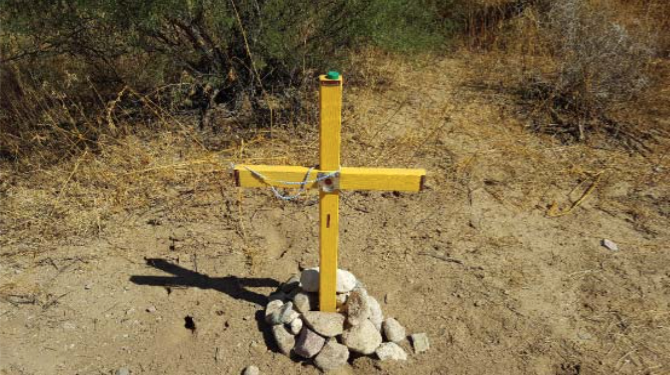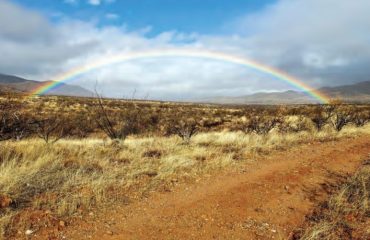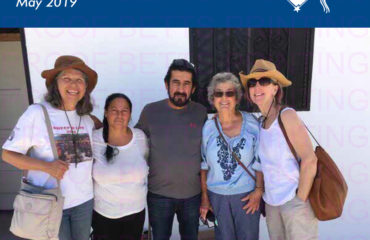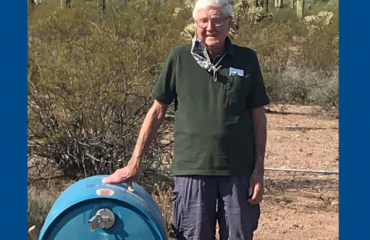– by Stephen Lee Saltonstall
The Desert Fountain Humane Borders December 2017
One of the sad realities that Humane Borders volunteers must face is that migrant deaths continue despite our best efforts, including in areas where we maintain water stations. We can’t predict exactly the routes migrants will be walking, and the patterns of migration change from week to week. A water station that may not have been used for a month may turn up needing 30 gallons of water on our next trip. We know there are hotspots that we can’t service due to the lack of roads or other factors, such as landowners who do not agree with our mission, or lack of sufficient resources.
I drive the Buenos Aires National Wildlife Refuge (“BANWR”) route every Friday. We service seven water stations, all of which are on dirt roads near Arizona Route 286, a north-south road that leads from Three Points, Arizona to the border at Sasabe. A look at our death map at www.humaneborders.info reveals that eight of the 117 sets of human remains discovered through October of this year were found in the general area of the BANWR route. Shockingly, four people died either very near or right at the side of Route 286. There are three crosses on Route 286, one of which is pictured on the cover, erected where a migrant died on the roadside in prior years.
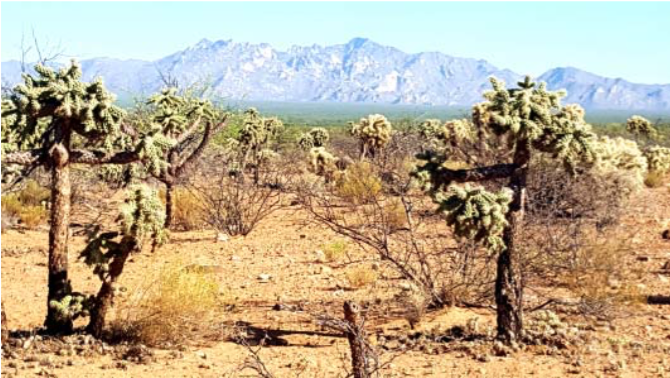
Looking east from the Humane Borders Bishop Carcano water station
Our volunteers often wonder aloud, “How could this happen?” How could a migrant expire on the roadside, with no one giving the dying person any life-saving help? Was it too dark for people passing by in cars or trucks to see the migrant in distress?
Did motorists, possibly including government workers, decide out of hostility or fear or lack of empathy to ignore the fellow human being in obvious need of help? Most importantly, what more can we as humanitarian workers do to stop this from happening?
Many of these victims cannot be identified because by the time they are found, their bodies have become skeletons, stripped bare by birds and coyotes and the elements. However, we know from the death map that on June 8, 2017, a 30 year-old man named Felipe Vargas Reynoso died of exposure and probable hyperthermia on the shoulder of Route 286, very near its northern terminus.
I would like to dedicate this issue of our newsletter to the memory of Mr. Reynoso. In his memory, I know that I speak for all of us when I pledge that Humane Borders volunteers will continue doing this work, and we will give it everything we have. We will do it with conviction, with dedication, with compassion, and with the utmost care. We won’t stop until all migrant deaths on our southern border come to an end.
United Nations Principles and Guidelines on Human Rights at International Borders (Summarized)
1. Address negative perceptions of migrant, including not using the term “illegal”; 2. Bring domestic legislation in line with international human rights standards;
3. Train border authorities in human rights and ensure that they have adequate resources and proper mechanisms to assure that such training happens;
4. Ensure that rescue operations provide for human rights, safety and dignity.
5. Ensure that immediate assistance in the form of food, water, blankets, clothing and sanitary items is provided as needed;
6. Provide for appropriate screening of people at border by ensuring individualized determination of reasons for entry and appropriate identification of people at risk;
7. Rapidly identify and refer migrants who may be at risk to appropriate entities; have interpreters, legal assistance and health care workers present;
8. Establish alternatives to detention and do not detain children based on their parents’ status;
9. Ensure that removals and returns are implemented with due process guarantees; 10. Implement strong bilateral, regional and international cooperation to promote human rights-based, equitable, dignified, lawful and evidence-based migration and border governance.
THE GLOBAL NEED FOR HUMANE BORDERS
BY DINAH BEAR
The United Nations High Commissioner on Refugees estimates that there are about 22.5 million people in the world today who in some way meet the definition of refugee(1), approximately 65.6 million forcibly displaced people in the world who do not meet that definition and another estimated 10 million people without any nationality at all. This human flow is unprecedented. There is no global convention or protocol dealing with the 65.6 million individuals who are neither stateless nor are considered refugees by their country of residence and who are generally referred to as migrants.
The International Organization for Migration reported that over 7,000 migrants died during 2016, a record high since the organization has tracked such deaths. Humane Borders’ map of migrant mortality (humaneborders.info) shows 117 deaths just this year (through October, 2017) in southern Arizona. These individuals were likely a mix of people who may have attained refugee status had they lived and those who would likely be classified as migrants.
In 2014, the United Nations, noting this unprecedented flow of human migration, developed Principles and Guidelines on Human Rights at International Borders. In the fall of 2016, for the first time since the negotiations following World War II, heads of states from all around the world came together in New York to discuss what was characterized as the “biggest humanitarian crisis of our time”. For the first time, that discussion focused on both refugees and migrants. Member countries decided to work on two separate global compacts – one for refugees and one for migrants, and to attempt to conclude both by the end of 2018. The process for negotiating the compact on migration is led by co-facilitators from Mexico and Switzerland.
Negotiations for both of these compacts involve a number of consultations around the world, working groups and, of course, drafting the compacts themselves. I represented Humane Borders at the U.S.-Canada Regional Civil Consultation focused on the UN’s proposed “Global Compact on Safe, Regular and Orderly Migration” in Washington, D.C. this September. A global
compact on migration presents a tremendous opportunity to elevate the stature of displaced persons to try to ensure humane treatment. However, civil society participants at the meeting expressed considerable concern that the focus of negotiations would be on the control and deportation of migrants rather than humane treatment. Providing an alternative, a core group of international organizations focused on migration has developed an advocacy document that will be used in subsequent civil society consultations and negotiations. The document is available here: http://madenetwork.org/ten-acts
Also this year, the United Nations Special Rapporteur for Extrajudicial, Summary or Arbitrary Executions, a post created by the United Nations Commission on Human Rights, convened an experts meeting on the Unlawful Death of Refugees in Migrants in New York City. Juanita Molina, Executive Director of both Humane Borders and Border Action Network, participated in that meeting and reviewed the draft report. (Humane Borders did not incur travel expenses for participation in either U.N. meeting).
The Special Rapporteur issued a final report that is highly critical of countries for failure to respect and protect refugees’ and migrants’ right to life and presents specific recommendations regarding such issues as access to justice and search and rescue. The full report is available here: http://www.un.org/en/ga/search/view_doc.asp?symbol=A/72/335
While Humane Borders’ priority for use of our limited resources will always be focused on preventing death in our own backyard, we are cognizant of the migrant deaths occurring worldwide and the tremendous challenges all displaced individuals face when forced by circumstances to leave their homes. Because we do have unique experience and concerns to contribute to the process, Humane Borders has applied for special consultative status with the United Nations organization involved in these efforts. To the extent possible, we will continue to follow and participate in these global developments.
___________________________
1. Under the 1951 U.N. Convention Relating to the Status of Refugees, a refugee is defined as an individual who has a “well-founded fear of being persecuted for reasons of race, religion, nationality, membership of a particular social group or political opinion . . . . “
WATER WITHOUT BORDERS
By John Heid
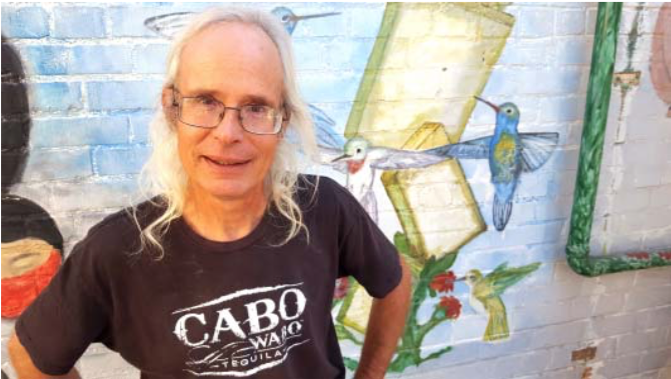
Within the past year local humanitarian aid workers became aware of a site two miles south of the U.S.-Mexico border, in Sonoyta, Sonora, where dozens of Central Americans were laid up in hardscrabble conditions, hoping to enter the U.S. Most, if not all, are candidates for asylum.
Our initial visit to Sonoyta revealed a soccer field size dirt lot scattered with makeshift tents and a small single story building alongside an arroyo (an arroyo is a small stream). The scene more resembled a refugee camp than a traditional shelter. We learned that there is one toilet, no reliable water, potable or otherwise, and no consistent source of food. The men we met were cooking rice and beans atop a 55 gallon drum wood fueled stove when we arrived.
Examinations by medically trained volunteers revealed myriad untreated injuries incurred en route primarily from Honduras and Guatemala. Nearly all the men were dehydrated and malnourished. Over the past few months the number of residents has pushed 100 and now includes several women. There’s no end in sight. The shelter is a kind of limbo. . . between worlds . . . between governments . . . between cultures and laws.
The conditions we observed offer a measure of insight into the increased number of deaths recorded in recent years in the Tucson Sector within a few miles of the border. Human Borders response to this situation has been to provide 325 gallons of water and attendant supplies to the shelter weekly. Our commitment is open-ended. Other U.S. based organizations are supplying food, clothing, blankets and medical aid.
Collectively, we have widened our vision of humanitarian aid, allies and solidarity with our neighbors to the south. In so doing, we have deepened our commitment to life, to human rights and to people seeking safe haven and family reunification.
Water is, after all, life… on either side of the border.
Editor’s note: John Heid lives in Ajo, Arizona, and is now Humane Borders coordinator there for our water stations in the far western portion of Organ Pipe Cactus National Monument and CabezaPrieta National Wildlife Refuge as well as our new work in Sonoyta. We appreciate his work with us and his devotion to human life.
Humane Borders Volunteer Profiles
 ERIK CLARK KOLSRUD, 22, is a Tucson native and University of Arizona senior who is majoring in Journalism. He plans to go to law school after graduation in 2018. His newspaper articles have been published in the Arizona Daily Star and the Tombstone Epitaph. Erik also serves as an intern at the South Tucson office of Cong. Raul Grijalva. Somehow he finds the time to drive the Ironwood Forest National Monument water run in season, substitute drives the Buenos Aires National Wildlife Refuge run as needed, and volunteers as a passenger on other runs as well. He has also recruited other U of A students to ride along with him.
ERIK CLARK KOLSRUD, 22, is a Tucson native and University of Arizona senior who is majoring in Journalism. He plans to go to law school after graduation in 2018. His newspaper articles have been published in the Arizona Daily Star and the Tombstone Epitaph. Erik also serves as an intern at the South Tucson office of Cong. Raul Grijalva. Somehow he finds the time to drive the Ironwood Forest National Monument water run in season, substitute drives the Buenos Aires National Wildlife Refuge run as needed, and volunteers as a passenger on other runs as well. He has also recruited other U of A students to ride along with him.
“I have always lived near the border, but I hadn’t thought much about the human issues involved with undocumented migration until I wrote an article about migrants in Nogales last year. That really opened my eyes, and I decided to write an article about Humane Borders, which led me to become a volunteer. I came to believe that we have a migrant crisis in southern Arizona, and that it’s a part of the larger, world-wide migrant problem, a link that people don’t always make.
“The organization’s humanitarian mission is excellent. The work really makes you understand what migrants go through when they cross the desert on foot. I know now that even one gallon of water from a Humane Borders water station can mean the difference between life and death.”
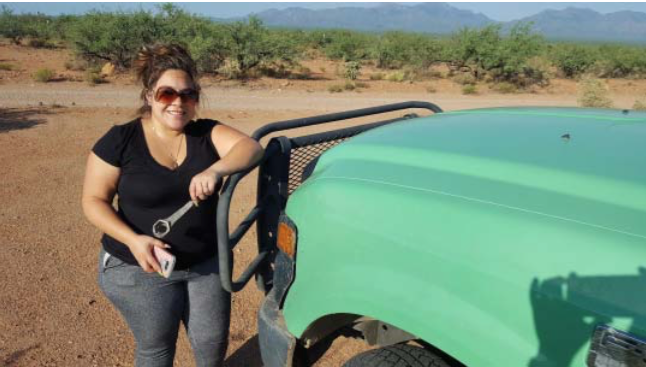 CANDY GRAJEDA lives in Tucson with her three daughters, Nischal, age 15, Dahniza, 10, and Jezahmey, 2. She attended Desert View High School, and she has an Associate’s Degree in Criminal Justice from Brookline College in Tucson. Candy has been volunteering for Humane Borders since the Spring of 2016, primarily on the Buenos Aires National Wildlife Refuge water run. She has also volunteered to pick up trash on Arizona Route 286, where Humane Borders has “adopted” a mile to clean up periodically.
CANDY GRAJEDA lives in Tucson with her three daughters, Nischal, age 15, Dahniza, 10, and Jezahmey, 2. She attended Desert View High School, and she has an Associate’s Degree in Criminal Justice from Brookline College in Tucson. Candy has been volunteering for Humane Borders since the Spring of 2016, primarily on the Buenos Aires National Wildlife Refuge water run. She has also volunteered to pick up trash on Arizona Route 286, where Humane Borders has “adopted” a mile to clean up periodically.
One of Candy’s talents is her knowledge of automobiles and automobile mechanics. More than once, she has offered helpful suggestions and gotten her hands dirty helping out with a mechanical problem with one of our trucks.
Candy supports Humane Borders and its humanitarian mission because “I enjoy helping people, and I want to make sure nobody gets hurt out there just trying to make a
better future”. Candy knows several undocumented migrants living in our community, and she characterizes them as “very good people,” and adds that, in her opinion, “Everyone deserves the same opportunities in life.”
Volunteer Dinner Starring TV Star Ed Asner
On October 14, 2017, Humane Borders held a dinner at the Tucson YWCA to honor some of its most outstanding volunteers. Ed Asner, star of the TV series Lou Grant and the Mary Tyler Moore Show, winner of seven Emmy Awards, and former head of the Screen Actors’ Guild, served as the master of ceremonies.
Mr. Asner presented Humane Borders awards to three deserving recipients, whose photographs are below: Lois Martin, a volunteer since 2005 and an inveterate activist who also works for No More Deaths and leads the opposition to Operation Streamline, the assembly-line “justice” meted out to migrants in the federal court system; Gary Wolfe, a former Board member who served ably as our Treasurer for seven years and who managed the renovation of the current Humane Borders office; and Gene Buell, a nine year volunteer and long-time faithful weekly driver on the Buenos Aires National Wildlife Refuge water run.
 Lois Martin with Ed Asner
Lois Martin with Ed Asner
Mr. Asner praised the work of the honorees and of Humane Borders generally, and he regaled the audience with a stirring account of his political work on behalf of the people of Central America, starting in the 1980s. Among other things, Mr. Asner opposed U.S. policies that included support for the far-right government of El Salvador and its notorious death squads. The reaction of TV executives to Mr. Asner’s advocacy was to cancel his show “Lou Grant,” even though it was rated in the top ten. Mr. Asner also lost his position as President of the Screen Actor’s Guild. Despite these personal setbacks, Mr. Asner continues his humanitarian activism, exemplified by his support of Humane Borders. (continued next page)
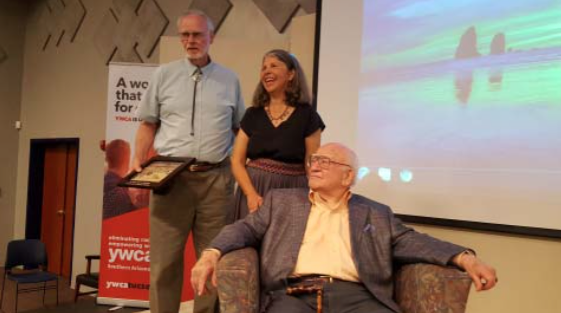 Gary Wolfe with Dinah Bear and Ed Asner
Gary Wolfe with Dinah Bear and Ed Asner
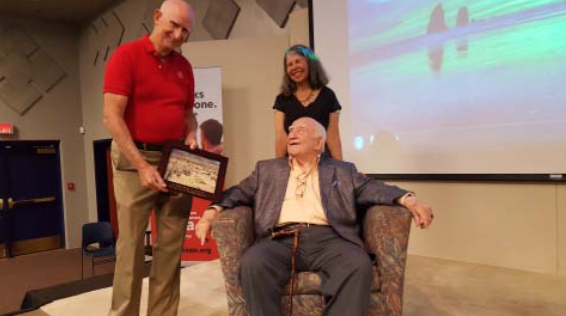 Gene Buell with Dinah Bear and Ed Asner
Gene Buell with Dinah Bear and Ed Asner
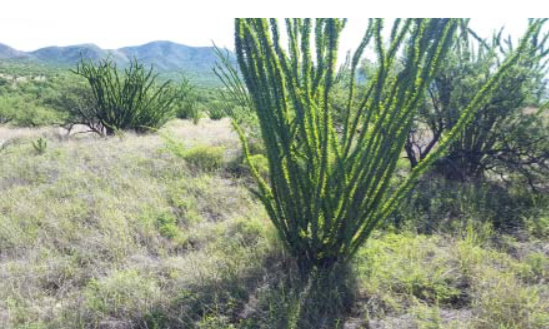 Octotillo near the Humane Borders Figuero water station
Octotillo near the Humane Borders Figuero water station
Loft Theater in Tucson Presents film Human Flow
On November 17th, Humane Borders partnered with the Loft Theater in Tucson for the showing of the film Human Flow. Directed by the Chinese activist and exile Ai WeiWei, the documentary was filmed in 23 countries and provides a graphic visual narrative of the 65 million displaced people around the world. A movie trailer and list of locations where it is showing can be found here: https://www.humanflow.com/ Additionally, it is available through Amazon Smile and is also available for free online viewing.
 Looking south near the Humane Borders Cemetery Hill water station
Looking south near the Humane Borders Cemetery Hill water station
THE TIM HOLT WATER STATION
All of our water stations are identified with a name, most frequently the name of a person or a geographic location. From time to time in the Desert Fountain, we’ll explore names of individual stations.
The Tim Holt water station is in Ironwood Forest National Monument. Cecil “Tim” Holt was from El Paso, Texas and spent much of his career in the military, reaching the rank of Master Sergeant in the U.S. Air Force. He settled in Tucson after his military service and became very involved in Humane Borders for nine years as both a driver and board member and Treasurer. Sadly, Tim passed away in May of 2009. A moving video of Tim telling a story of how he saved a lady from El Salvador found near a Humane Borders’ water station can be found here: https://www.youtube.com/watch?v=aHmzpLhI9iU
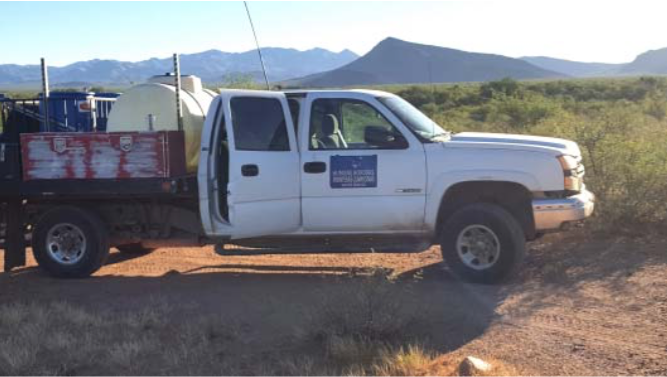 Looking north from the Humane Borders Bishop Carcano water station
Looking north from the Humane Borders Bishop Carcano water station
HUMANE BORDERS ADOPTS A MILE OF HIGHWAY 286
Humane Borders recently adopted mile 22-23 on Highway 286, the route that we travel weekly to service seven water stations and to give water to Grupo Beta in Sasabe, Sonora. We will generally host or participate in four cleanups a year.
On January 27, 2018, we’ll participate in a cleanup of the entire highway all the way to the border. This is your chance to be part of the only clean-up in the U.S. of an entire highway! The cleanup is sponsored by Rancho Sierra Vista de Sasabe, the Altar Valley Con- servation Alliance and the Arizona Department of Transportation. Safety vests, bags, trash pickers and snacks will be provided. If you are interested in participating with Humane Borders, please send us an email at: info@humaneborders.org!

